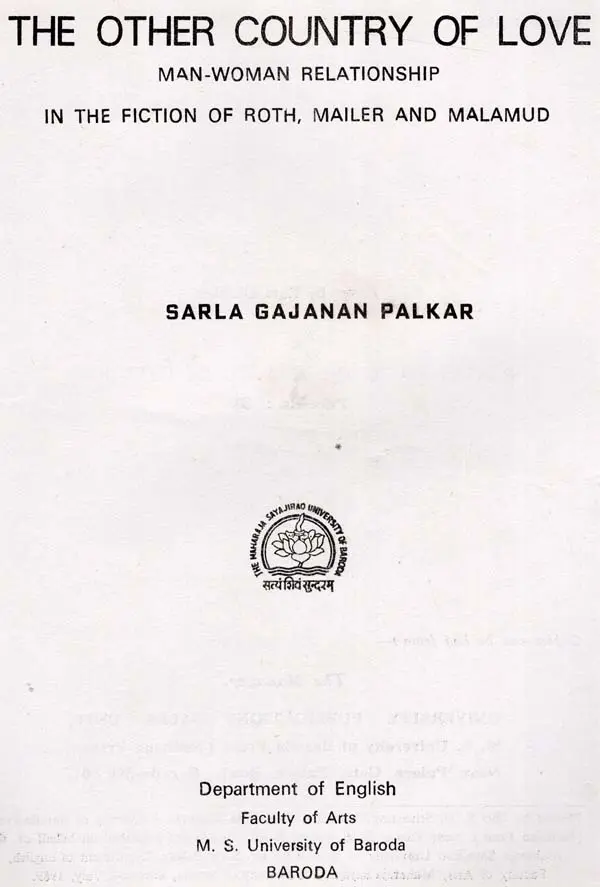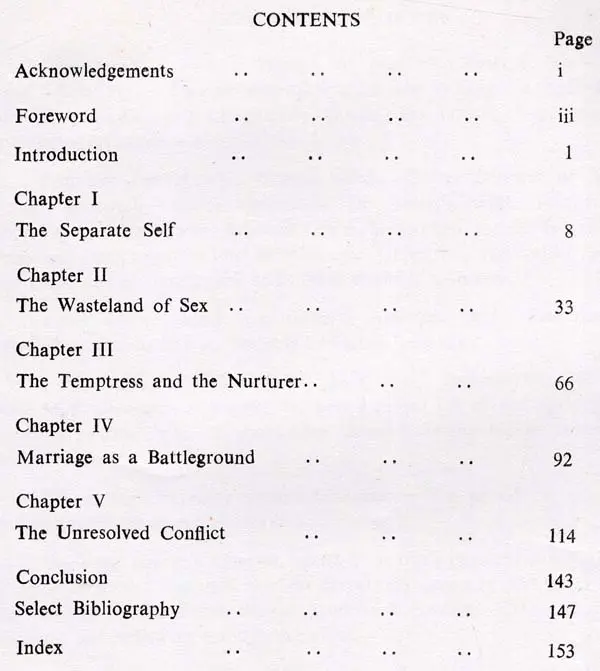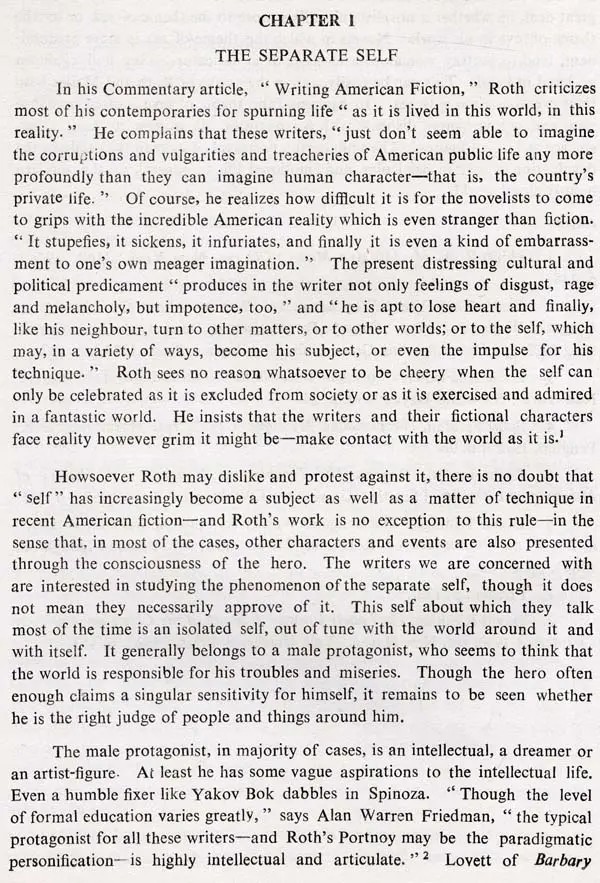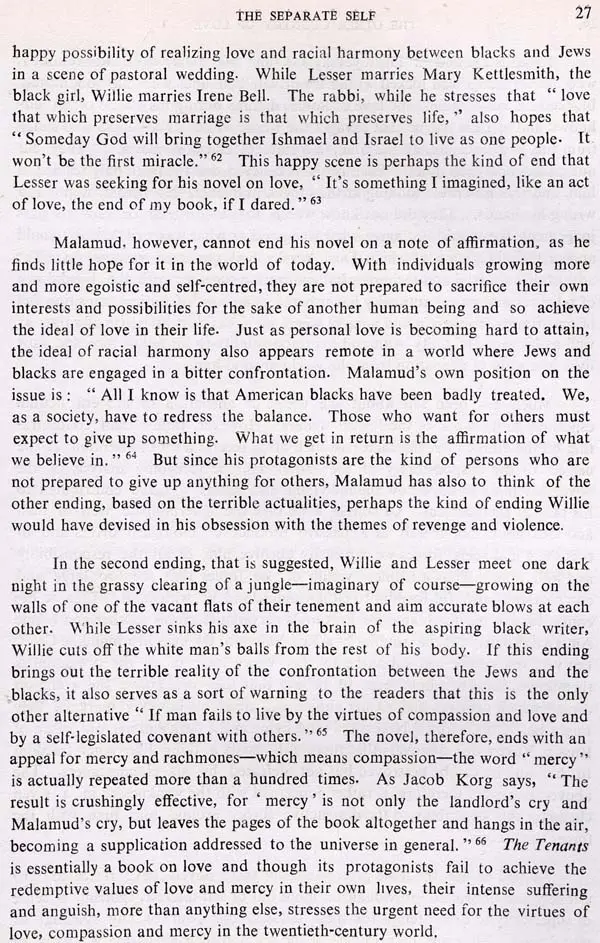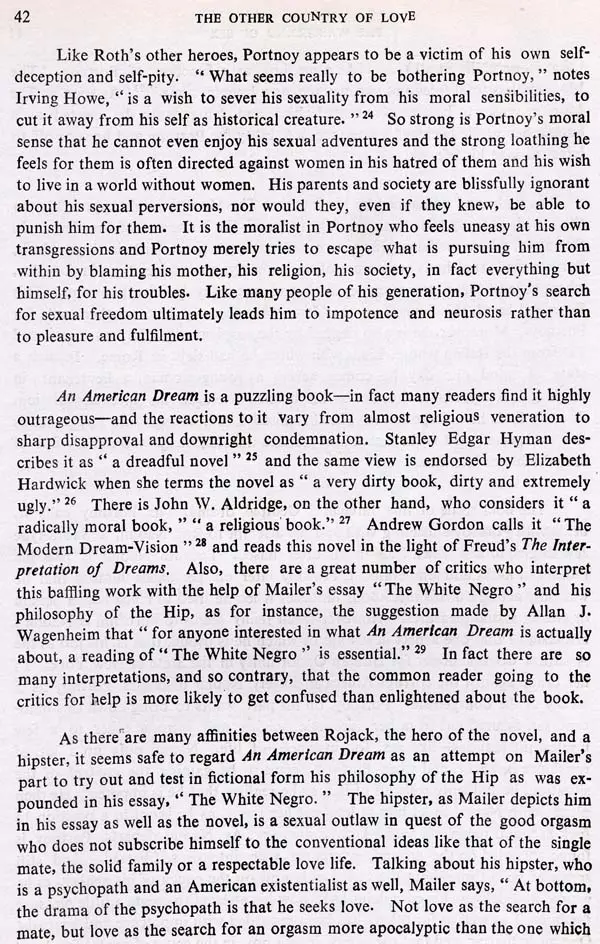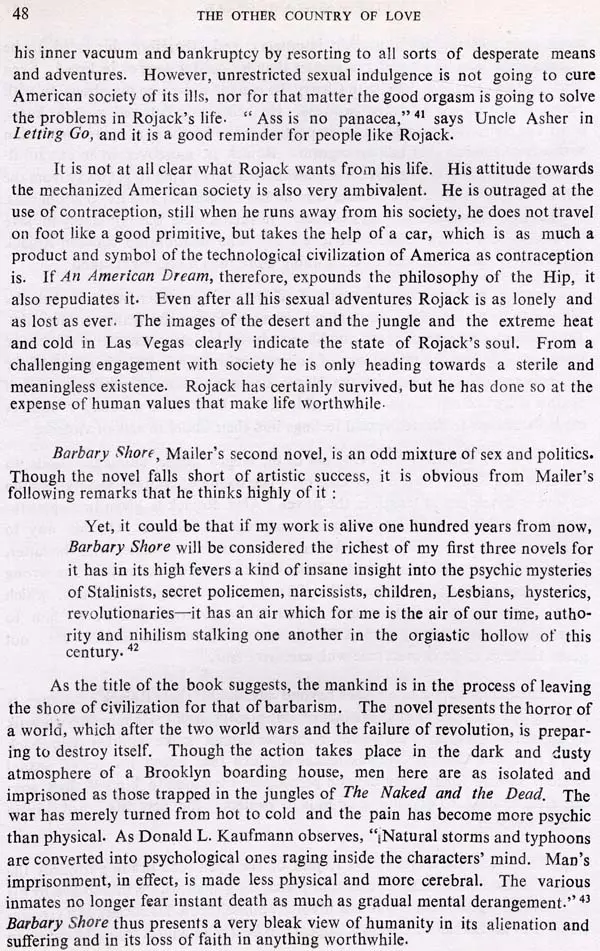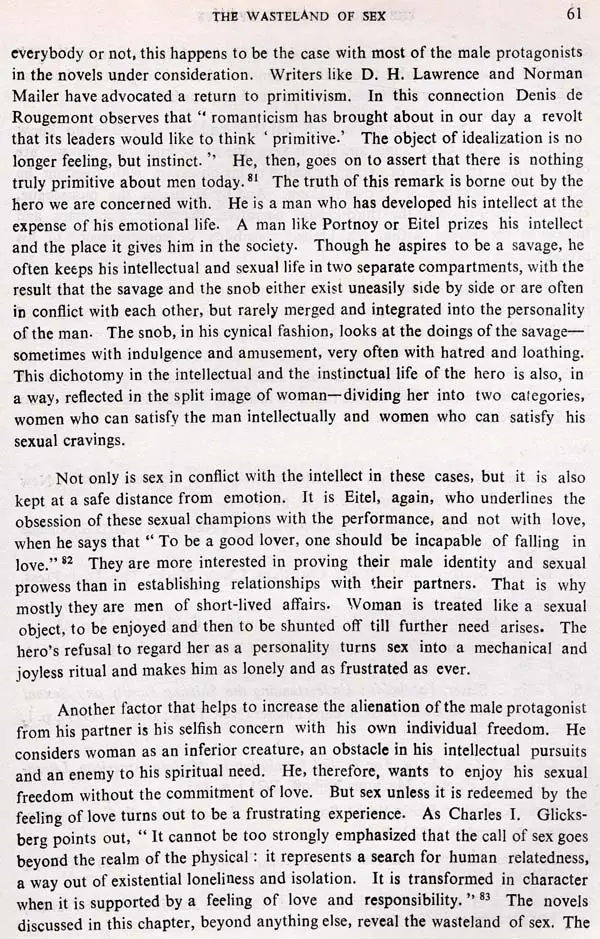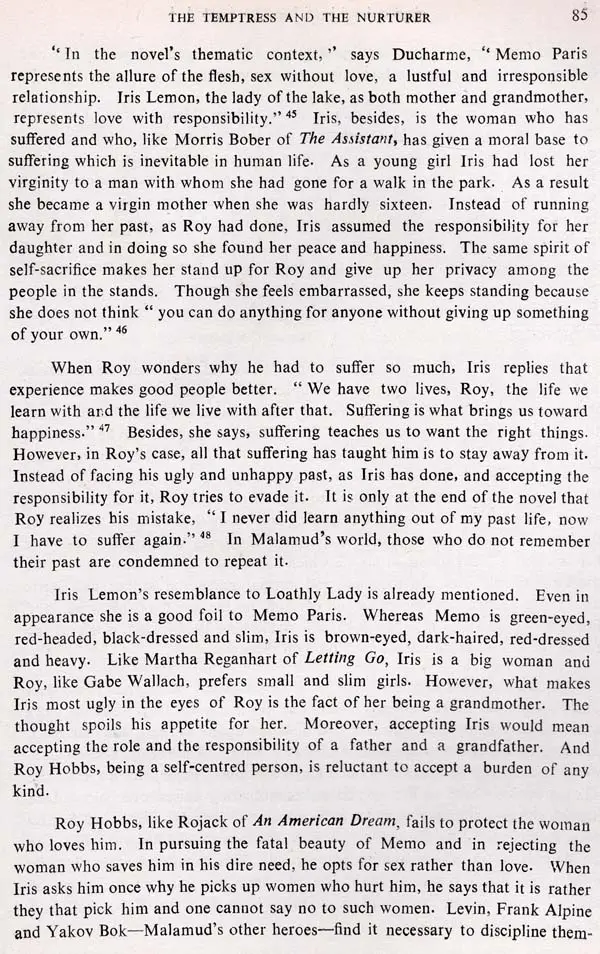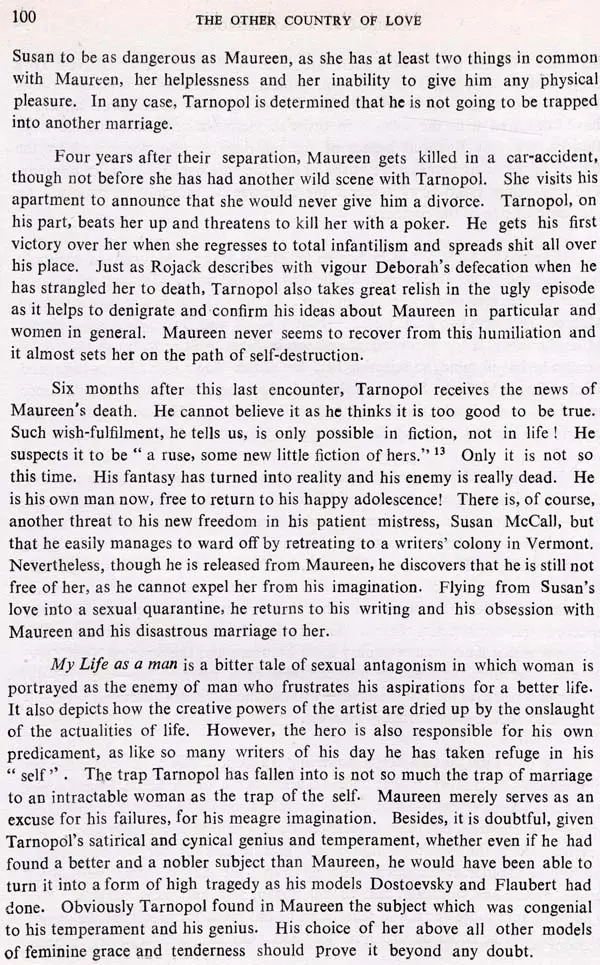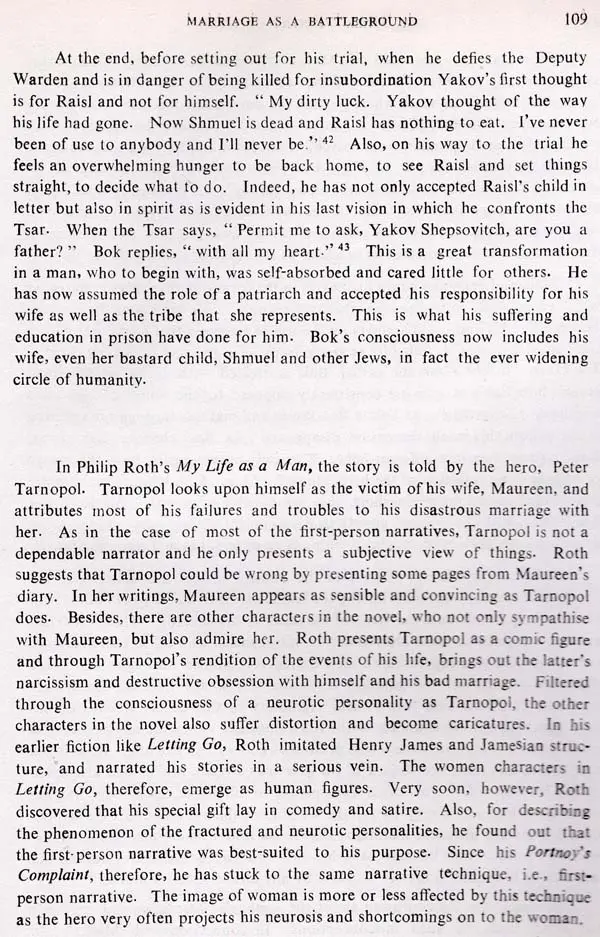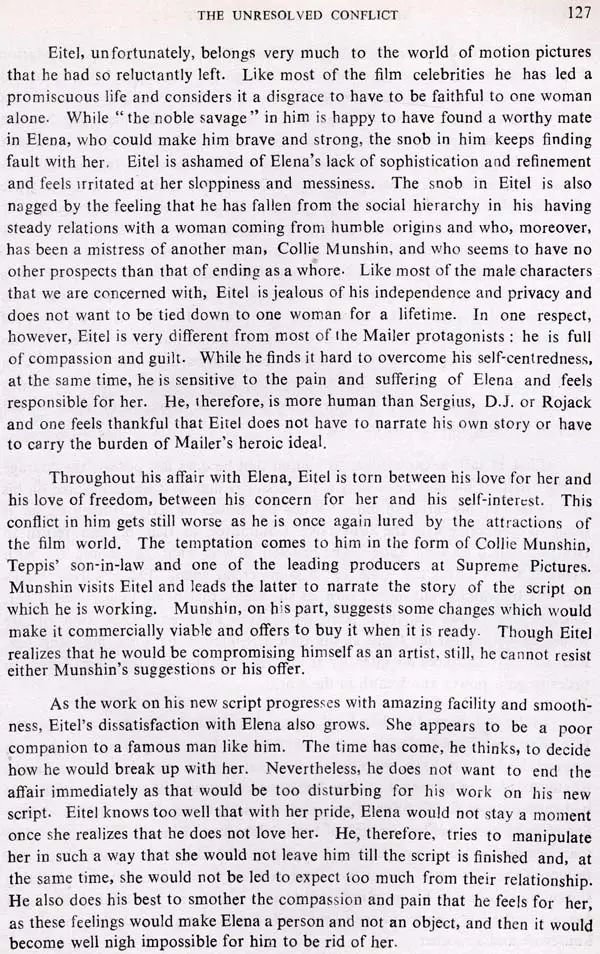
The Other Country of Love Man-Women Relationship in The Fiction of Roth, Mailer And Malamud (An Old & Rare Book)
Book Specification
| Item Code: | UAR189 |
| Author: | Sarla Gajanan Palkar |
| Publisher: | The Mahraja Siyajirao University of Barodra |
| Language: | English |
| Pages: | 151 |
| Cover: | PAPERBACK |
| Other Details | 9.50 X 7.00 inch |
| Weight | 230 gm |
Book Description
It gives me great pleasure to say at the outset that I have enjoyed reading Dr. Sarla G. Palkar's work on man-woman relationship in the fiction of Roth, Mailer, and Malamud, which is published here under a changed title. Dr. Palkar's book is a thoroughly-revised and updated version of her doctoral dissertation submitted to the M. S. University of Baroda in 1982. The topic of Dr. Palkar's exploration is highly relevant now. After the turbulence of the Sixties and early Seventies has passed over to the restitution of the late Seventies and Eighties, the subject of man-woman relationship has acquired a new dimension. There is no longer a campaign against Man by the radical feminists; no longer a militant aggressive posture by women to establish their independence from and sometimes their superiority over men. Now things have settled down to a serious appraisal of the nature of gender conflicts in cultures and of the way women have been constructed through centuries. Increasingly, more and more women are seeking support and collaboration in their work from men and more and more men are perceiving women's struggle with understanding.
Now feminism as a literary and cultural philosophy has more male supporters than ever. It forms part of the whole deconstructive strategy to overthrow various kinds of structures of hegemony and power ubiquitous in every culture and society. Hence as a transgressive force, it has far-reaching consequences on human activities. In such a perspective of new revisionism currently taking place in the complex nature of gender relationships, Dr. Palkar's book on man-woman relationship in the fiction of Roth, Mailer, and Malamud is timely. She has taken up a sensitive topic and has looked at it from various angles without being guided by any ideology or bias. She has tried to trace the dominance of the male figure in American literature right into its Puritanic origin and has rightly suggested that the various stereotyped women figures in the work of these three novelists are the products of the culture in which they are placed. She does not attribute any motives to their authors for creating destructive women, thereby avoiding the rather problematic issue of the author-protagonist relationship; on the other hand, she maintains that women become destructive due to collapse of marital ties as a result of economic and industrial pressures on them. This is a valuable insight. In her book The Feminization of American Culture, Ann Douglas suggests a similar thesis by identifying the dominance of the male over female in American culture through a process of systematic conditioning, a conditioning which finally created the mystique of the feminine" as the ultimate consumable product of the male dominated culture.
Even a most casual reading of the works of writers like Bellow, Mailer, Roth and, to some extent, Malamud might make one conscious of their obsession with the image of a destructive woman, a woman who makes man's life a living hell for him and who prevents him from realizing his high aspirations in life. So great, indeed, is the hold on their imagination of woman as a villain or a victimizer that one may be tempted to give them the same advice that Morris gives to his brother, Peter Tarnopol, in Philip Roth's My Life as a Man: What is it with you Jewish writers? Madeleine Herzog, Deborah Rojack, the cutie-pie castrator in After the Fall, and isn't the desirable shiksa of A New Life a kvetch and titles in the bargain? And now, for the further delight of the rabbis and the reading public, Lydia Zuckerman, that Gentile tomato. Chicken soup in every pot, and a Grushenka in every garage. With all the Dark Ladies to choose from, you luftmenschen can really pick'em. Peppy, why are you still wasting your talent on that Dead End Kid? Leave her to Heaven, okay?' Of course, Morris is mainly referring to shiksas or gentile women here, but the Dark Ladies, the Jewish Princesses, are not satisfied either with what they call the distorted presentation of themselves in the novels of the leading Jewish American writers. While pointing out the disparity between a modern Jewish woman and her image in the fiction of Jewish male writers Carole Zonis Yee remarks that modern Jewish woman is active alive, creative and outspoken. And yet if a Jewish woman looks in modern letters for her counterpart, she finds herself portrayed as threatening, destructive, and the keeper of the home with its attendant misery. 2 These writers, therefore, have come in for severe criticism for what is considered to be their shabby treatment of woman. Some people even go to the extent of maintaining that woman hardly exists in their fiction, while others, especially feminists, attack them as "male chauvinists " or misogynists, who have tried to establish male supremacy and given vent to their hatred for woman through their fiction.
The obvious reason for the unfair treatment of woman appears to lie in the author's main interest in his male protagonist, who seems to share some of his creator's concerns, and the narrative technique that he adopts, where events and characters are mostly presented through the consciousness of the hero. In the fiction of Roth, Mailer and Malamud women figure mostly as they act upon the hero in his journey through life. Since women are of secondary interest and as they are in a majority of cases seen through the eyes of the male protagonist, they generally remain strange and remote figures. Kafka, who may be said to have set this trend, is a case in point. His women-figures are strikingly different from those of other European writers, particularly Tolstoy or Dostoevsky. One gets the impression that either Jewish authors have some difficulty in understanding female psyche or, more likely, they do not consider the subject worth their trouble. As male protagonists usually occupy the centre of the story, the nature and the character of a woman is defined largely by the role she plays in the life of the hero. The delineation of woman, therefore, tends to become simplistic rather than complex.
She is either inimical to the interests of man, a destructive bitch, or she is a nurturer, subservient to his needs. What Leslie Fiedler says of the American writers in general is also true of the Jewish writers to a great extent: "they rather shy away from permitting in their fictions the presence of any full-fledged, mature women, giving us instead monsters of virtue or bitchery, symbols of the rejection or fear of sexuality. "3 That is why perhaps, with all their greatness, Bellow, Mailer, Roth or Malamud, like their European counter part Kafka, do not have complex women characters in their fiction. The Jewish writers also seem to have been particularly benefited by the twentieth-century's debunking of the romantic idealization of woman. With the "ghetto deeply imprinted on their imagination, they are more at home in depicting the filth of life than its beauties. Indeed, the ugliness and the squalor of the "ghetto" are now concentrated in a woman's body and their heroes take great delight in harping on the unattractive characteristics of woman or exposing her ugly aspects. Add to this her lack of intellect or her intellectual pretensions. and one would not why their men find it so difficult to accept a woman, irrespective of her being "good" or evil. At her worst she is like poison, at her best she is like a bitter pill one may swallow for one's health but which one does not enjoy in any case. Moreover, in their preoccupation with the themes of alienation and suffering they are more likely to conceive of women as the instruments of alienation and suffering than of love and happiness. So these writers present us a galaxy of destructive women Madeleine Herzog, Deborah Kelly. Maureen Tarnopol, Sophie Portnoy, Memo Paris and others.
Several explanations are offered by the feminists for the prevalence of the predatory female in the writings of the Jewish authors. Writers like Eva Figes or Kate Millett are apt to attribute it to the persistence of patriarchal attitudes which are deeply imbedded in the Jewish as well as the Puritan mind. It is maintained by feminists like Betty Friedan that Jewish cul ture inculcates in men the inferior and subordinate position of woman as is well illustrated in the daily prayer to be said by men: "I thank Thee, Lord, that Thou hast not created me a woman. 55 4 As in the Jewish tradition the importance of maleness is paramount, whether it is in their God or his worship per, woman is relegated to an ancillary role. It is argued, moreover, that the story of the fall and the role Eve played in man's fall from grace and Paradise is indelibly imprinted on the Jewish as well as the Christian mind. Hence the theme of woman as the source of all man's troubles is likely to recur, in one form or another, in the writers who are brought up in that tradition. In their preoccupation with the image of a woman who frustrates man's plans for a better life, many Jewish male authors easily lend themselves to the charge of being patriarchal in their attitudes to women. The feminists are unanimous in looking upon Sigmund Freud as the great perpetuator of the patriarchal thought. In fact, they consider most of Freud's work as part of a male conspiracy to keep women in subjection. Whether Freud himself intended it or not, he had an adverse effect on the image of woman as is pointed out by Katharine M. Rogers when she remarks that the twentieth century attitude toward women was profoundly influenced by one man: Sigmund Freud. His theories have further undermined romantic idealization, given what appears to be scientific support to prejudices inherited from the nineteenth century, and supplied a distinctively modern form for the dread of the omnipotent female." While it is difficult to determine precisely the influence of Freudian thought on each author, it is safe to assume that the modern image of woman is more or less coloured by Freudian concepts about women.
Concepts like Oedipus complex, penis envy and castration complex have particularly led to the portraiture of dominating and possessive mothers like Sophie Portnoy or emasculating women like Deborah Kelly, Lucy Nelson, Harriet Bird, Maureen Tarnopol and others. Besides, the delineation of women as a distracting influence or hindrance to the higher pursuits of the mind may also owe something to Freud's ideas about the fundamental conflict between Eros and civilization. In modern literature woman has also come to be associated more and more with the irrational or absurd forces of life that destroy the order a man is trying to create out of his life. One may call her his "fate " or the "circumstance" or the "necessity" or the "pressures of reality" before which he feels helpless or powerless. As the theme of quite a few novels is the confrontation of the self and the society or the world at large, typically enough this confrontation begins at home, between man and woman. "What we have, then, says Diana Trilling," is a literary culture, if it is only a literary culture, in which man lives in isolation from his society and in which his society reannounces itself in woman; in which, that is, woman is in essence either a predator or a husk, an uninhabited body supplied with the mechanical appurtenances for the satisfaction of the sexual appetites and the continuation of the unhappy human kind. any rate, such is the situation as it exists for the male writer." 6 As woman and society have become synonymous, the hero's rejection of the one signifies his rejection of the other and intensifies his alienation from the rest of humanity. His acceptance of woman, by the same law, means his acceptance of social reality and strikes a note of affirmation in the novel.
The persisting image of the destructive female or bitch, in the writings of the Jewish as well as other American writers, is also attributed by writers like Betty Friedan to the general escapist tendencies of the post-World-War-II era. This was the time, it is pointed out, when there was a vogue for early marriages in American society and, instead of going for an independent career for themselves, a majority of women tried to exist in and through their husbands and children. Men also took shelter in their private lives because, it is argued, they could not find any true value in contemporary society. attack on women, "The unremitting says Betty Friedan, "which has become an American preoccupation in recent years might also stem from the same escapist motives that sent men and women back to the security of the home. "7 This line of argument traces the present image of woman in literature to its sociological roots and maintains that woman became subordinate to man in literature because she had ceased to be an independent entity in actual life. As I have said earlier, the majority of novels by Roth, Mailer and Mala mud narrate the story of a man's life. The average hero in these novels is either a bourgeois intellectual or an artist or a dreamer. He is a man who finds it extremely difficult to relate himself to other human beings. Sentimental about himself and equally cynical about others, he fails to see the "humanity" of others. To him, it appears, he is the only "human norm, the only one who suffers. He is a self-centred man concerned with his own individual salvation and his own identity. The paradox about identity, however, is that one cannot cultivate it in one's cell or one's ivory tower or one's bell-jar, apart from social environment; it grows out of one's "engagement" with the world. The protagonists, in the novels under discussion, in most cases, fail to realize this truth about identity. Also, they confuse the inner freedom with the outer freedom. In their excessive concern with their "self" and their freedom, they are reluctant to face social reality and accept their responsibility to their fellow human beings.
Imprisoned in their own ego and victims, generally, of their self imposed alienation, the world appears to them a part of a conspiracy against the individual. The woman becomes then, as their most intimate relationship is with a woman, the instrument or the embodiment of the world that is trying to destroy the individual. Very few heroes achieve self-realization through self transcendence.
**Contents and Sample Pages**
